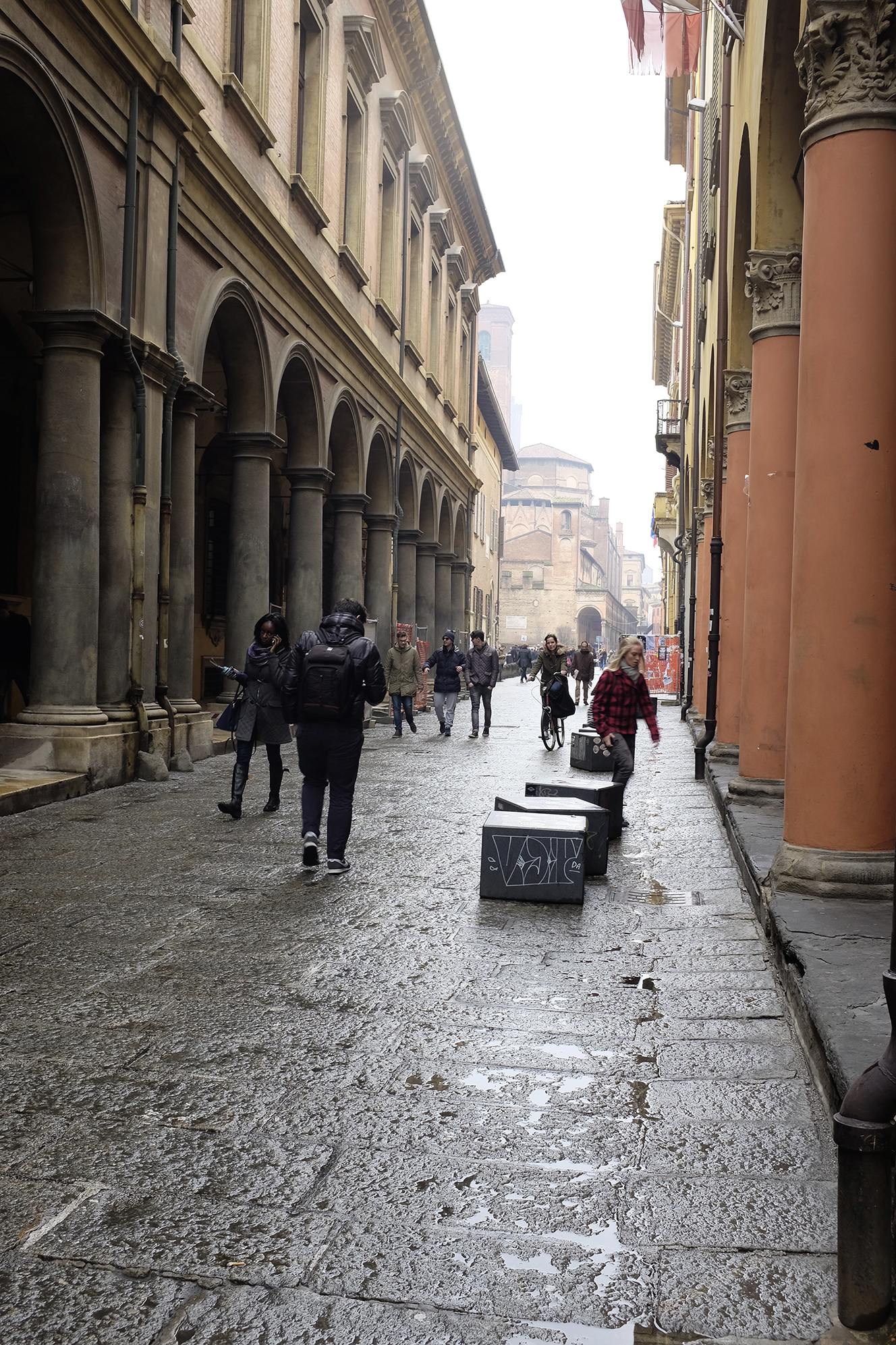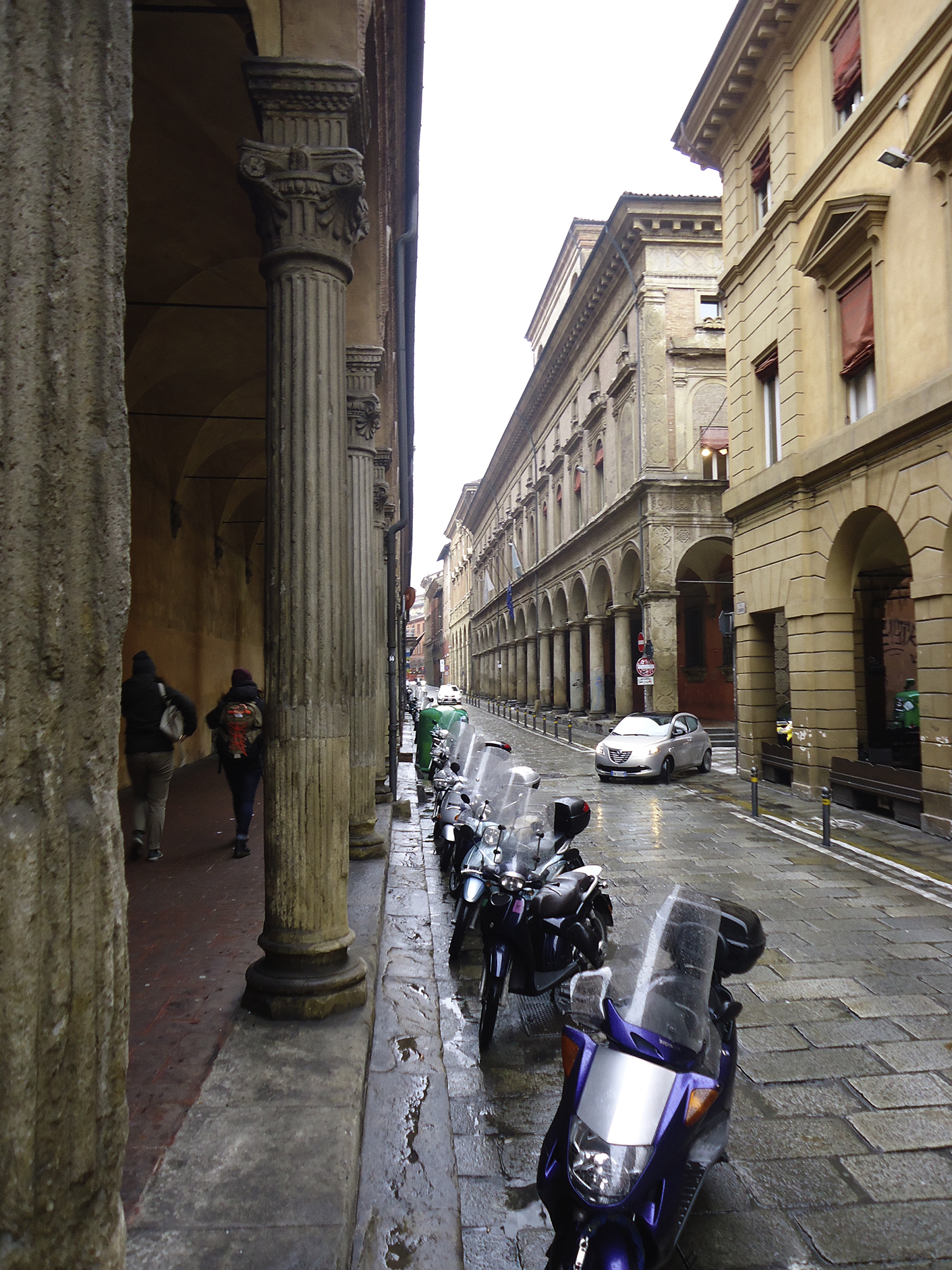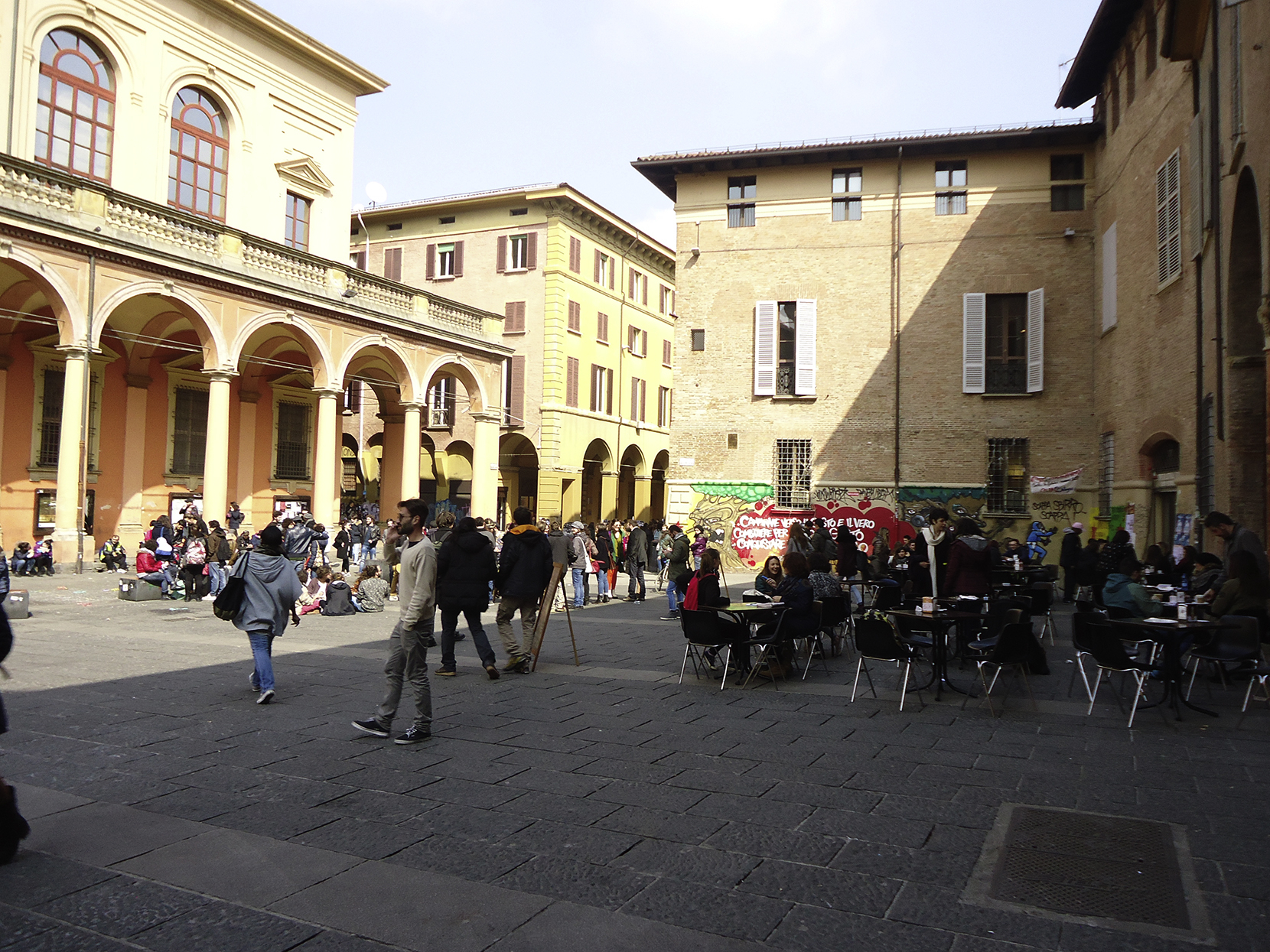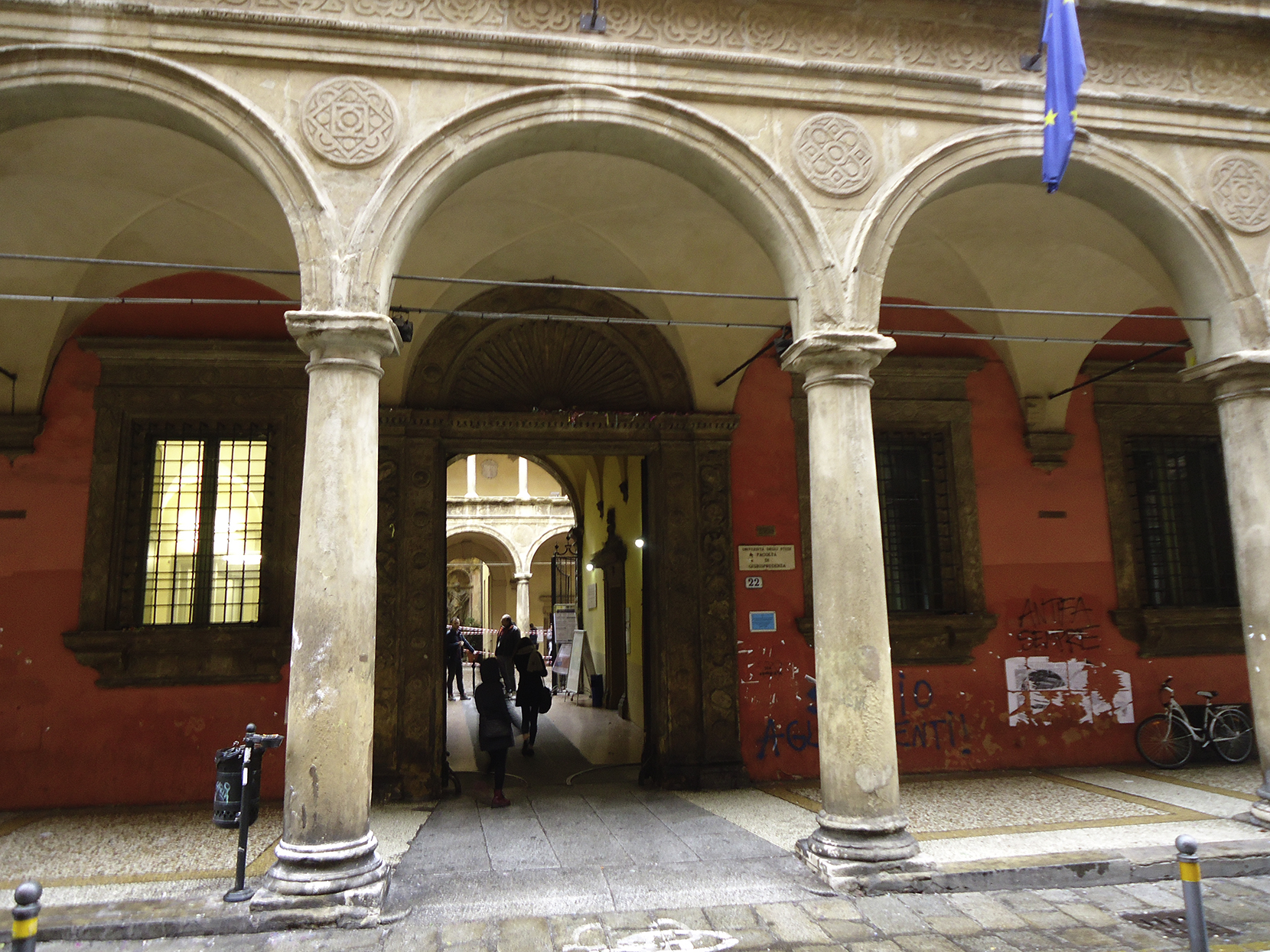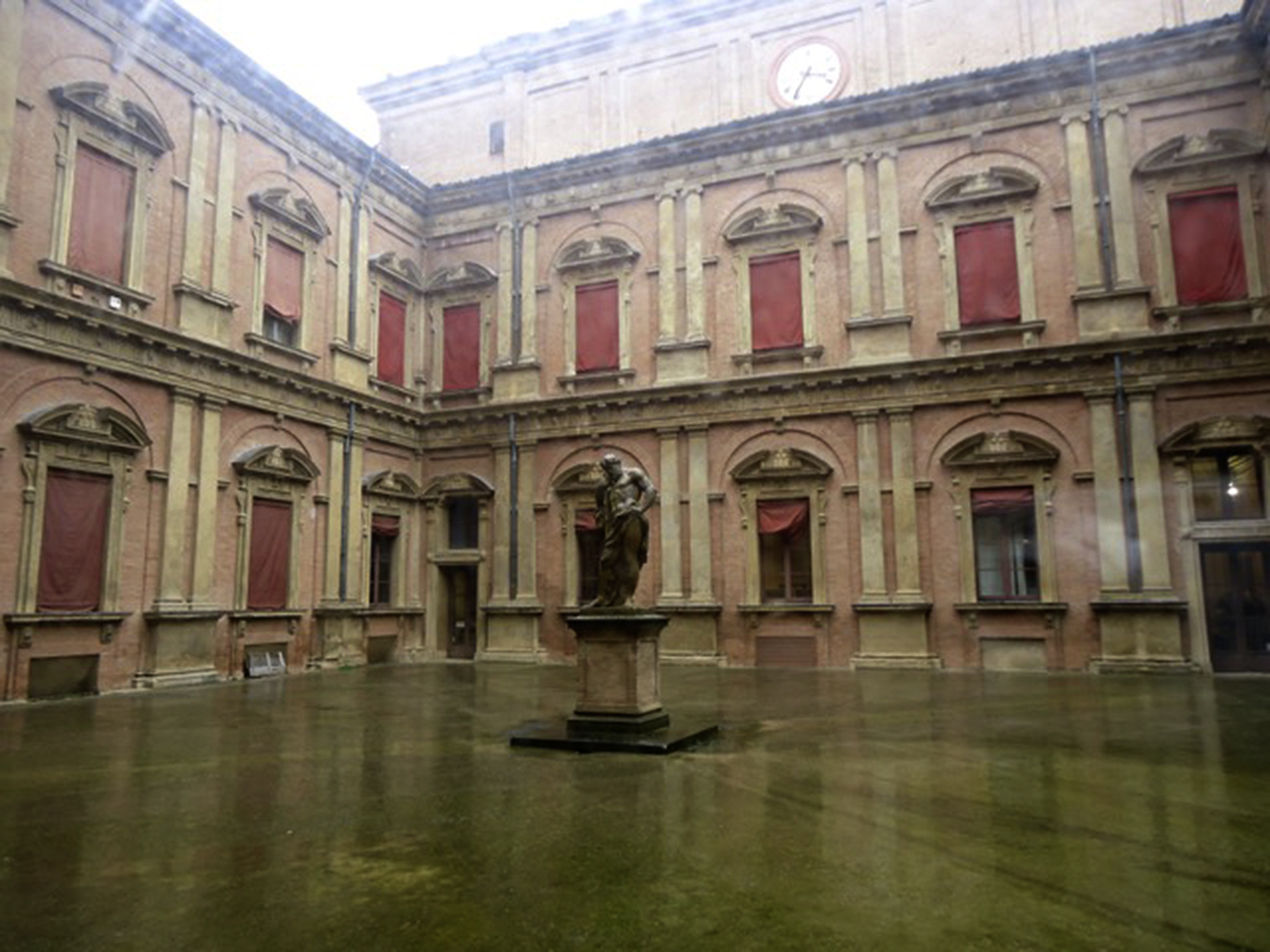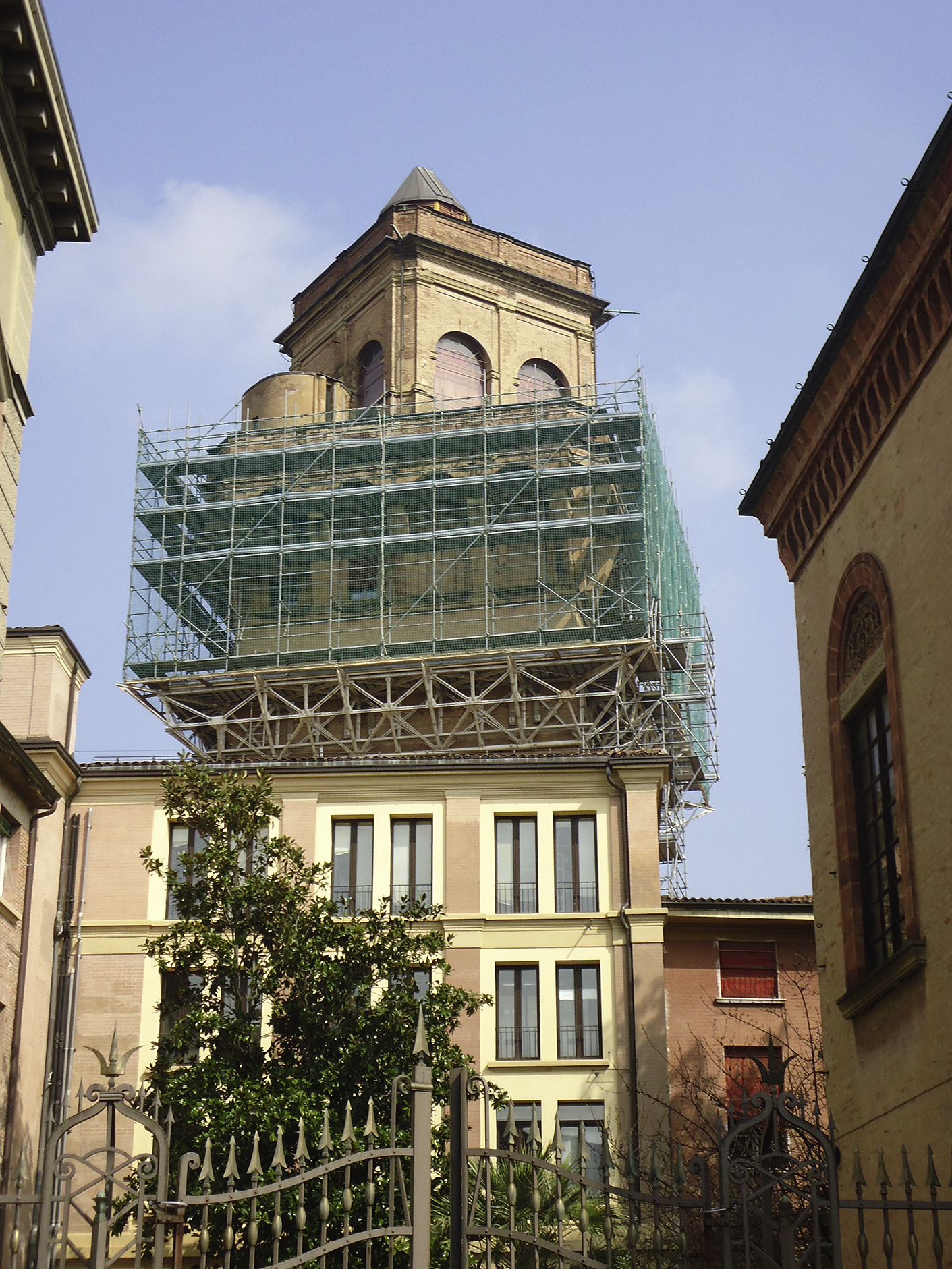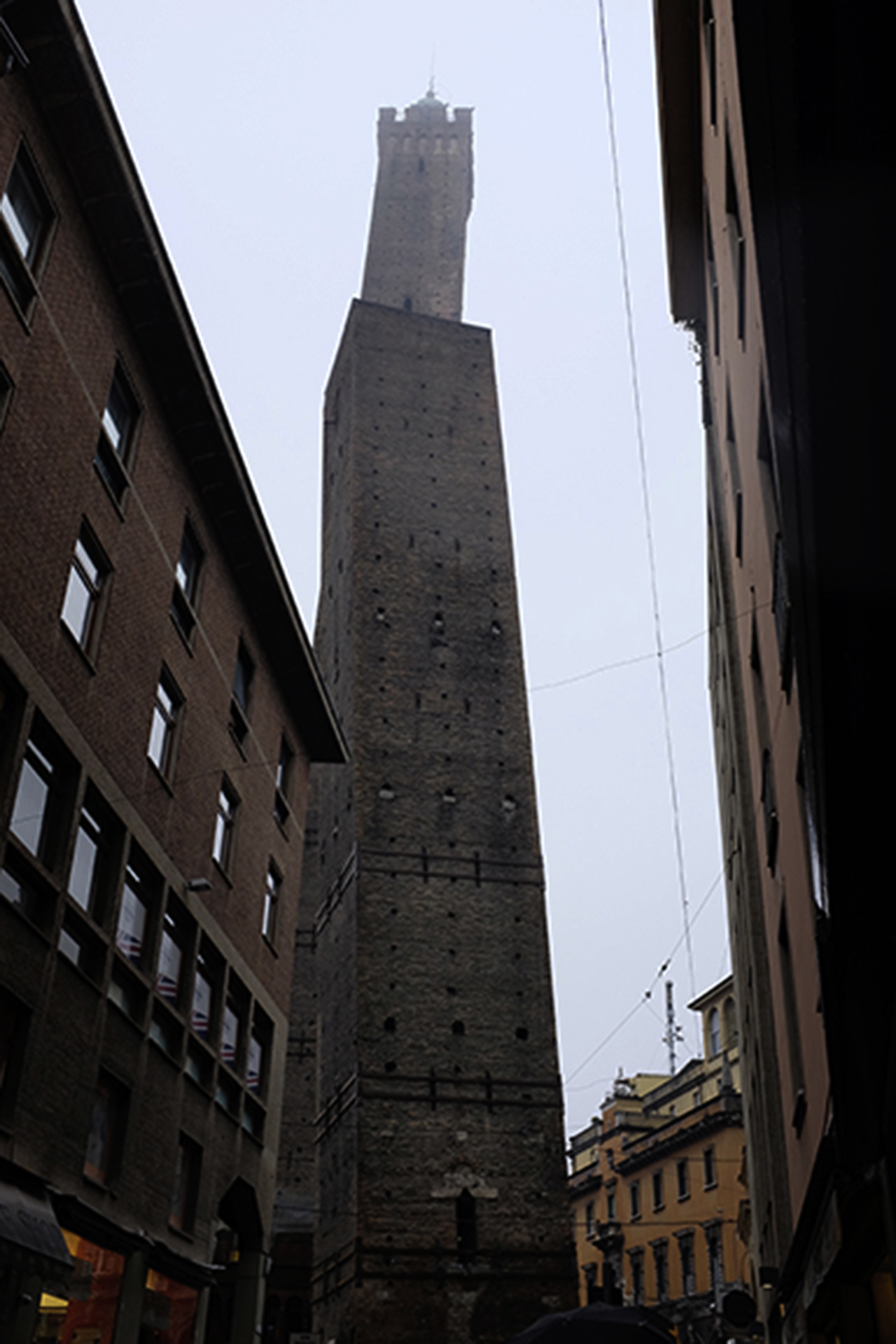Chapter 10
University of Bologna
Abstract
The history of the University of Bologna is in some ways the history of the modern university: Bologna provided a blueprint for many institutions to follow. Italy’s oldest and preeminent university sees itself as a kind of mother figure (Alma Mater Studiorum) and very much enjoys playing the role. Today, the University of Bologna is a powerful mix of tradition and innovation, mindful of its past and focused on its future.
Keywords
Bologna; Italy; History; Legal scholarship; Architecture; Porticos; Women in academe; Electricity; Libraries; Museums
The University of Bologna, it can be said with some confidence, was a recognised centre of learning well in advance of its incorporation as a university in the pre-modern sense. The institution came into being adventitiously, not as the outcome of a medieval strategic planning exercise or as the result of a mandate issued from on high: it ‘“just grew,” arising slowly and silently without definite record’ (Haskins, 1965, p. 4). Its official date of founding, 1088, was in fact determined by a committee of historians, chaired by the university’s Nobel Prize-winning poet Giosuè Carducci, in 1888. Despite the lack of substantiation, the university was keen to celebrate its octocentenary that same year, and the impeccably timed ruling of the ad hoc commission provided the necessary green light for the festivities to proceed. And so, in June 1888, an extended programme of convivial if somewhat chaotic commemorative events, both formal and informal, took place in the ancient city, with royalty, civic leaders, students, and professors from near and far paying tribute to Alma Mater Studiorum (Kind Mother of Learning) (Kirkpatrick, 1888)—the moniker that was adopted later and is now used extensively by the university to reinforce its global brand, appearing on buildings, stationery, websites, and all kinds of paraphernalia (Figure 10.1).
A hundred years after the colourful octocentenary, the University of Bologna was instrumental in creating the Magna Charta Universitatum Europaeum, a largely symbolic document affirming higher education’s traditional core values of institutional autonomy and academic freedom. Amid considerable pageant, the rectors of more than 400 universities signed the charter under an azure sky in Bologna’s main square, the Piazza Maggiore, on September 18, 1988. Many more institutions have since added their names to the list. In 1999, the university also gave its name to a major pan-European initiative, the Bologna Process, which is designed to improve transparency and ensure compatibility in educational standards across the member states of the European Union. This has proved to be a juggernaut of a reform. Its critics, of whom there is no shortage, see the drive to create a common market for educational wares as the McDonaldisation of higher education (de Pommereau, 2010).
Bologna—‘foundress of all Universities’ and ‘nursing mother of the great Italian Renaissance’ (Kirkpatrick, 1888, p. 38)—has no intention of sharing the limelight with any other when it comes to bragging rights relating to ancientness: the committee-decreed date of 1088 is now a given, a ground truth, at least as far as the Bolognese are concerned. Professional historians are rightly cautious when it comes to dating, as the surviving records are often vague or incommensurable; some scholars might wish to argue that Paris should take precedence over Bologna. Paul Grendler (2002), in his magisterial The Universities of the Italian Renaissance, cautiously dates Bologna’s founding as somewhere between 1150 and 1180 (p. 6). Determining the university’s date of birth is problematic because, unlike many other ancient universities, Bologna cannot point to a charter or bull that clearly and incontrovertibly specifies the exact moment of its conception: ‘Pope and emperor, the twin towers of medieval authority, played no substantive role in the birth of the University of Bologna’ (p. 7).
∗∗∗
The year 1158 is another landmark in Bologna’s illustrious history, as it was then that Emperor Frederick Barbarossa, or Frederick I, promulgated the Authentica (or Constitutio) Habita, which enabled the fledgling institution to develop in autonomous fashion. This crucially important document, a distant precursor, one might say, of the 20th-century Magna Charta, can be considered a pioneering bill of academic rights in that it afforded legal protections to the various groups or guilds of students (societas socii) from different countries who had taken up residence in the city. The student body (those not from Bologna) was divided into two major groups, or nationes as they were known: the cismontanes (students from south of the Alps) and ultramontanes (students from north of the Alps—foreigners in other words). Given that many students hailed from places well beyond the city and tended to form fraternal associations based on regional or national identity, it made practical sense for these polyglot communities, instead of squabbling and fighting with one another, which they had been doing as a matter of course, to assert themselves with one voice and, at the very least, make it more difficult for the local citizenry to harass or take advantage of them. Strength in numbers became the smart thinking within the outsider community. In a move that would have significant reverberations, locally and farther field, a student association (universitas scholarium) duly assumed responsibility for appointing, evaluating, paying, and dismissing the teachers, and even electing the rector. The students exercised tight control over their masters, specifying, for example, how and at what pace the syllabus should be covered. Tardiness was a punishable offence as was skimming over difficult texts; fines were often levied for such breaches of the statutes. If a teacher chose to marry during the semester, the hard-nosed students would grant the individual but one day and one night for his honeymoon. Contemporary teaching quality audits have nothing on Bologna’s stringent evaluation system: back then a professor’s performance ‘was continuously assessed by the students on both a qualitative and quantitative basis’ (Cobban, 1980). Life for the medieval lecturer was no bowl of cherries, certainly not with a student committee called the Denouncers of Professors on the prowl for slackers and delinquents.
Having established their association—a ‘mutual benefit society’ is how Alan Cobban (1980) describes it—students in the 12th century had greater leverage in their dealings with the burghers of Bologna. They could, if severely provoked, take themselves and their business elsewhere. Many of these early students were not without means and moreover were mobile: in other words, they had economic bargaining power and weren’t going to be held hostage by the locals. And so it was that Bologna became the prototypical student-led university, an institution that attracted, in particular, young men with wealthy or aristocratic parents. One sometimes has the feeling that Italian students, despite the passage of time, have not forgotten their heritage or lost their willingness to confront authority, in whatever guise it may appear. Student unrest and radicalization have been staples of modern times in Italy; neither the presence of tanks in the streets of Bologna nor the political killings in the 1970s will be easily forgotten. The city of Bologna continues to live up to her left-leaning reputation, not least in the university where Marxism has not fallen wholly out of fashion.
This innovative self-governing model did not, however, go unchallenged. A considerable counterbalancing occurred in the 13th century: first when the professorate followed the lead of the students and themselves banded together to better advance their collective interests, and later when the farsighted commune of Bologna decided to pay the salaries of the professors itself by using a variety of tax revenues for that purpose. This development had a stabilizing effect, putting the university on a more secure footing. It also showed that the city recognised the value of having a university in its midst: students were, after all, much more than loutish ne’er-do-wells who ‘drove up housing costs, disturbed the peace, and violated women’ (Grendler, 2002, p. 7). It had become quite apparent that students were a lucrative source of both income and municipal prestige, stimulating the expansion of the city by creating demand for services, accommodation, and material goods. In fact, by the mid-14th century, Bologna’s population was roughly 30,000. The university had a ‘lay spirit’ (Rashdall, 1987, p. 137) and went about its business largely untroubled by ecclesiastical interference or debilitating doctrinal squabbles. The city administration, initially in the shape of a four-person oversight body, gradually assumed responsibility for most university affairs, including the appointment of professors. Students, for their part, began to expect a certificate of sorts from their professors showing that they had successfully completed a course of study. Thus came into being the original licence to teach (licentia docendi), even if it was not always used for that purpose; it can be thought of as the precursor of today’s academic degree. The imbalance in power had been addressed, and bottom-up management soon became a thing of the past.
Between the 14th and 15th centuries, the average number of professors at the university fluctuated, from a low of 31 in the 1370s to a high of 110 in the 1450s, while the number of matriculated students ranged from roughly 1,500 to 2,000 (Grendler, 2002, p. 9). Although the medieval student body was impressively cosmopolitan in nature, the same could hardly be said of the professorate. Many of the teachers in the early days of the university were local figures, often from good families, and it was not unheard of for a son to succeed to a chair held by his father—a practice, in fairness, that was not peculiar to medieval Bologna. Still, the university’s reputation continued to grow such that it became a magnet for young men from all corners of Europe; among those who studied there were Francesco Petrarch, Albrecht Dürer, Nicolaus Copernicus, Dante, and Erasmus, names once known to every schoolboy.
∗∗∗
Italian universities in general tend to not fare especially well in the various annual international rankings that have become an inescapable measure for universities—nepotism (Allesiana, 2011) and the influence of ‘politically connected professorial baroni’ (Rothblatt, 2008) undoubtedly have taken their toll in Italy. However, given its longevity, the University of Bologna has strength in depth across a wide range of subject areas, including anatomy, anthropology, geology, mineralogy, paleontology, pathology, and zoology. Its high-ranking law school is probably its most enduring success story.
It all began here with the study of legal texts a thousand or so years earlier. The historical evidence shows that scholars were teaching civil and canon law in the city of Bologna in the 11th century, so it is correct to say that a community or association (universitas) of sorts existed, albeit one that lacked a formal organisational structure or any of the institutional trappings taken for granted today. The focus of these early scholars’ attention was the Corpus Juris Civilis, the body of civil law that had been codified in the 6th century by the Emperor Justinian and that was used to govern the Roman Empire. By the early Middle Ages, it had all but disappeared from view. Exactly how and why Bologna emerged as the epicentre of this recrudescence of legal scholarship is not altogether clear, but the beneficial consequences soon would be. Preeminent among the early glossators—those who commented on and glossed such legal texts—were first Pepo and then Irnerio, the latter being one of the most famous professors of law in the Middle Ages. A 19th-century painting of Irnerio, housed in the Palazzo d’Accursio, shows the busy glossator at work bent over his texts—very much an idealized reconstruction. It would be a stretch to say that either of these good fellows is today a household name outside of Bologna, but in their time they were influential and well-regarded figures. The same holds for Gratian, a Benedictine monk, who, assuming he in fact existed—the record is rather blurry on that key point—not only taught Thomas Becket but also played a key role in promoting the teaching of canon law at the university; his Decretum, which became the standard compilation in the field, was, in the words of Rashdall (1987, p. 127), ‘one of those great text-books which, appearing just at the right time and in the right place, take the world by storm.’ This, then, was a city of scholars. Around Bologna, in churches, on walls, and today in museums, there can be found stone panels (often one side of a famous scholar’s mausoleum), depicting professors such as Gratian speaking ex cathedra to his students, some listening attentively, some writing, some seemingly bored or distracted. Such was student life in the Middle Ages; such is student life today. There is a fine example of one of these representations embedded in the exterior wall of the Church of Saints Vitale and Agricola, near the heart of the university (Figure 10.2).
The University of Bologna’s growing reputation as a centre of legal scholarship allowed it to draw students from all corners of Italy and indeed from much farther afield, including England and Scotland. Students from Spain (then as now) might be lucky enough to be housed in the beautiful Collegio di Spagna, a cross between a monastery and a fortress. The building, which curls along the street named after it, dates from 1365 and is the most famous residential college in the city (Figures 10.3 and 10.4). Bit by bit, teaching in the prototypical university expanded to cover other subjects such as theology, philosophy, and medicine, the last of these being a discipline in which the institution would subsequently make an indelible mark. Bologna was among the first to incorporate surgery and anatomy into the curriculum, which up until then had been dominated by such stalwarts as Aristotle, Galen, and Hippocrates: this was, lest one forgets, ‘a bookish age, with great reverence for the standard authorities, and its instruction closely followed the written word’ (Haskins, 1965, p. 28). Much of the credit for the shift to what might be called today evidence-based teaching is due to Mondino de Luzzi, known as Mundinus, a native of Bologna who studied at the university before joining the faculty (something of a family tradition in his case, as it happens) in the early part of the 14th century. With great determination, he promoted the systematic study of anatomy and routinely carried out public dissections in the presence of both students and interested others. His magnum opus, Anathomia corporis humani, published in Padua, is held to be the first modern dissection manual. In the nomenclature of the period, Bologna was now a university of ‘jurists’ (legisti) and of ‘artists’ (artisti), as those studying in all fields other than law were known.
∗∗∗
The modern visitor to the city will seek in vain to unearth evidence of the university’s original premises. Bologna may be the oldest of the Greats and Ancients, but unlike some of its peers (e.g., Oxford), there is next to no surviving architecture from early times. In the university’s formative period, professors taught in their own houses or availed themselves of rental properties, as was the case in many other parts of Europe. Different faculties came to be associated with different city neighbourhoods. A commemorative plaque on the exterior wall of the church of San Salvatore in Via Volta Santo records the fact that this quarter was home to many of the first schools (Medicine, Philosophy Rhetoric, and Astronomy) that made up the original Alma Mater Studiorum between the 13th and 15th centuries (Figure 10.5) South, along Via Farini, now home to fashionable shops, the medieval visitor would have found many of the elements of the early book trade: copyists, booksellers, bookbinders, paper makers, and miniaturists. Students, then as now, needed to get their hands on the set texts used by (and more often than not based on the lectures of) their professors, and ‘the stazionari were expected to produce pecie (small booklets of four sheets of skins/paper, a total of sixteen pages)’ for the local market (Noyes, 2009, p. 181). These could be borrowed for a modest charge, with damage or loss resulting in a fine. This was the pre-library era, the age of manual reproduction and hand-made copies: Johannes Gutenberg’s revolutionary printing press would not arrive on the scene until the middle of the 15th century. Accuracy in copying was thus a matter of understandable concern, such that the university had a team of ‘supervisors and correctors’ (Haskins, 1965, p. 38) whose job it was to carry out spot checks on the books for sale within the university domain. The light hand of regulation—historically and, to this day, a feature of the publishing industry—was already discernible in what has been called ‘this little world of books’ (Gieysztor, 2003, p. 128). The heavy hand of regulation was in evidence in the second half of the 16th century during the time of the Inquisition when Bologna’s printers and booksellers had to swear that they were not producing or selling books that were unapproved.
For some time, the nascent institution lacked a symbolic centre; it was in reality little more than a constellation of free-floating teachers. From the 16th right up to the beginning of the 19th century, however, the University of Bologna was synonymous, physically speaking, with the Palazzo dell’Archiginnasio; it was to Bologna as the Palazzo Bo was (and still is) to the University of Padua (Figures 10.6 and 10.7). This elegant edifice, today partly hidden from passing view by the awnings of up-market emporia, was originally built in 1563 at the instigation of the Roman Catholic Church, which by then had firmly established its authority over the heretofore secular university and its curriculum. The building, two levels around a courtyard, consists of 30 arches supported by carved stone pillars. Most striking is the profusion of decoration throughout the arches, on the ceilings, and up the staircases. Inscriptions, paintings, carvings, and hundreds (if not thousands) of plaster coats of arms of former scholars and students, bearing names and nationalities, encrust the walls (Figure 10.8). The upper level had 10 classrooms and two large lecture halls, one each for the artisti and the legisti. The hall of the legisti, a profusely decorated space ringed by old books, is today used for public performances and lectures. Since 1842, it has been known as the Stabat Mater Aula to commemorate the first-ever performance of Gioachino Rossini’s oratorio, which took place there under the baton of Gaetano Donizetti. The upper floor also houses one of the world’s oldest and most beautiful anatomy theatres, built in 1637 by Antonio Levanti. The spacious, high-ceilinged room is made entirely of wood. As a result of extensive damage to the Palazzo from a bomb during World War II, the present room is very much a reconstruction, albeit a faithful one. Those observing the dissection sat on three tiers of wooden benches, behind which a fourth row stood. The lector’s elevated podium has a canopy over it supported by two freakish, skinless figures, the Spellati. In niches around the walls are carved wooden statues of eminences from the history of medicine, including Galen and Mundinus (Figure 10.9).
Four and a half centuries ago, a visitor to the city would have been left in no doubt that the Palazzo dell’Archiginnasio was the beating heart of Alma Mater Studiorum, with begowned students and professors scuttling hither and thither across the courtyard and up the staircases to the various lecture halls, classrooms, and the anatomical theatre. Today, the university’s premises and often-overcrowded classrooms are scattered throughout the city, but the centre of gravity is on and around Via Zamboni. Many departments, administrative offices, and museums, not to mention a small university shop (Unibo) selling logo-covered merchandise, are gathered together along and to the east of Via Zamboni, the so-called area universitaria (Figures 10.10, 10.11, and 10.12). The colonnaded porticos that funnel students in and out of the quarter echo the incessant clamour and chatter. In pulsing Piazza Giuseppe Verdi, strewn with beer bottles, and along Via dei Bibiena, heroin addicts shoot up in broad daylight while dealers and panhandlers go about their business openly. To which circle of Hell would Dante, a distinguished alumnus of the university, assign these wretches? Still, it is hard to think of any other university hub in the world with such a concentrated, cacophonous vibe.
Many of the main university buildings, from the cavernous Palazzo Poggi to the capacious Zoology Museum in the old city, are grand of scale, as presumably behooves Alma Mater Studiorum. The grandeur that once was is still there but has been taken down a notch or two (Figures 10.13, 10.14, and 10.15). The façades of the palatial buildings that house many of the administrative offices and academic units, such as the Faculty of Law with its Renaissance courtyard, are somewhat scuffed, besmirched with aggressive graffiti: they have seen life and could tell a tale or two. Music spills out of bars and cafes, adding to the term-time din. Dottore, Dottore! rings out in sing-song bursts as garlanded, pantomimic graduates, carrying flowers and sometimes covered in flour, along with their carefree families and friends wind through the streets fortifying themselves with swigs of Prosecco. The merriment is contagious; this goliardic rite of passage is appreciated by one and all. Should the jollity prove too much, the nearby Oratory of St Cecilia on Via Zamboni offers an oasis of calm. Just to the north of the historic city, a major new university complex is being developed in the Navile district, adjacent to the high-speed rail terminus; it will be home to the Departments of Chemistry, Pharmacy, Biotechnology, and Astronomy. Another outlier is the School of Business, which, as befits would-be future masters of the universe, is located outside the city in the sylvan setting that is Villa Guastavillani, a 16th-century residence adapted to the demands of the 21st century, where the standard Master’s in Business Administration (MBA) can be customized; an MBA (taught in Italian) with a specialization in Food and Wine is just one of the available options.
Amidst the exuberance and excess of the university quarter one finds the monumental Palazzo Poggi, construction of which began in 1550. Following the university reforms of 1803, the Palazzo became, and to this day remains, the seat of the university. It houses the rector’s offices as well as the collections and library of the Academy of Sciences (Accademia delle Scienze dell’Istituto di Bologna). Established in 1711, Accademia delle Scienze dell’Istituto di Bologna was the brainchild of General Luigi Marsili—a visionary collocation of laboratories, galleries, and workshops in an attempt to spur experimental science and observation; an astronomical observatory in a tower atop the Palazzo was added a short while later. The academy flourished during the Enlightenment, adding greatly to the reputation of the university, and by the early 19th century, it had been incorporated fully into the university. Today, the Poggi Museum—a gargantuan Wunderkammer—contains a wealth of scientific exhibits and instruments, ranging from Ercole Lelli’s exquisitely executed and displayed anatomical waxworks to a collection of large-scale model ships, military fortifications, and canons; it has, quite rightly, been described as ‘an encyclopaedia for the senses’ (Tega, 2005, p. 12). Many of the museum’s rooms have frescoed walls and richly painted ceilings: the eye is overworked, the brain overstimulated. The Palazzo is also home to the university library. The historic collection, which began life as the library of the Accademia delle Scienze dell’Istituto di Bologna, is housed within a cathedral-like reading room, the Aula Magna. Today the beautiful chamber is used exclusively for receptions and concerts. There is also a very large collection of portraits painted between 1500 and 1800, hanging high and low wherever space will permit. Pass through a short corridor and the glamour of the Aula Magna gives way to a functional modern university library, a feature of which is a fully automated storage and retrieval facility containing 500,000 books. The cavernous Palazzo also contains an interior courtyard, the centrepiece of which is a statue of Hercules by Angelo Piò (Figures 10.16 and 10.17). On the ground floor sits the Aula Carducci, named after the beloved man of letters whose committee did what needed to be done in 1888. This behemoth of a building really does contain the spirit of the institution.
Along nearby Via Irnerio, named after the great legal scholar, are many imposing 19th-century university buildings—one could almost be in Vienna or Berlin—housing various scientific and medical departments. In front of the Institute of Physics there is a fine bronze bust mounted on a plinth of Augusto Righi, who did important work on electromagnetism and microwaves during his time at Bologna; Guglielmo Marconi, a Bologna native and Nobel Prize winner, was a student of his. Righi’s look is sternly professorial, his mustache grand in its ordered sweep, and a beribboned medal dangles on his chest: the Hughes or the Matteucci Medal (Figure 10.18)? Further along, another no less imposing edifice, the Institute of Anatomy, is home to a really rather special museum. The visitor passes along a corridor lined on both sides with hundreds and hundreds of skulls in glass cases—shades of Rwanda. Upstairs there is a stupendous collection of anatomical waxworks, brightly displayed and clearly labeled. This is a case where viewer discretion might be advisable: many of the cabinets are filled with lifelike renditions of massive tumours, cysts, and physical deformities of every imaginable kind. After this, a breath of fresh air is in order, and where better than the nearby Botanical Garden that began life in the second half of the 16th century? What greets one, however, bears no resemblance to the antique model on display in the Poggi Museum or what the earliest visitors would have beheld. Gone is the four-sided symmetrical layout, in its place a rectangular swatch of land hemmed in by the city that is as unkempt as it is uninspiring. But there are mitigating circumstances: over the centuries the garden has been relocated several times and to make matters worse the present site was badly damaged by wartime bombing. While the pinkish Institute of Botany building, with its specialized library, is not devoid of charm, sadly, the same cannot be said of the gardens.
∗∗∗
The city of Bologna is an enchanting mix of yellows, pinks, terracotta, and reds, and with its covered walkways, airy squares, ancient walls, countless churches, basilicas, and palaces—to say nothing of Le due Torri, the sideways-leading Garisenda and the skyscraping Asinelli—is a near matchless and fitting host to Western Europe’s self-proclaimed oldest university (Figures 10.19 and 10.20). In fact, Bologna once boasted so many towers it must have resembled a medieval Manhattan. Legend has it that anyone climbing the Asinelli tower (almost 500 steps) before graduating will not be awarded his degree. Chief among the many architectural features that set the atmospheric city apart are its vaulted porticos. These provide year-round protection from the elements and create naturally inviting spaces for social interaction and commerce. Their origins can be traced back to the 1200s when the influx of students seeking accommodation put pressure on a city corseted by protective walls and unable to spread laterally. As a result, the commune permitted property owners who housed students to extend the street-facing wall of their premises to create additional accommodation: privatisation of public space for the common good (Noyes, 2009). Thus came into being the celebrated porticoes of Bologna, initially made of wood and later of brick or stone, all 38 or so kilometres of them. They are without a doubt grander than those of Padua, but it has to be said, they lack the intimacy of the porticos of the city’s friendly rival across the plains.
Over the years, the city of Bologna has acquired several nicknames: la Grassa (the ‘fat one,’ a reference to its rich cuisine), la Rossa (acknowledgement of its communist sympathies, or the colour of its roof tiles), and la Dotta (the ‘learned one,’ an allusion to its famous university). Its past is millennially long and eventful, though not all of it is immediately obvious to the casual observer. There exists, for example, a network of canals that was once used for a variety of commercial purposes, making the city a mini-Venice of sorts. Bologna flourished—it was one of Europe’s largest cities in the 12th century and it sparkled again during the Renaissance—but it also suffered at times and fell into occasional decline (the Black Plague took a huge toll). Internecine fighting (between rival families and their militias) and imperial conquest (Pope Giului II took the city in 1506; Napoleon wrested it from the papacy at the close of the 18th century) also left their mark, as did World War II (the city was bombed repeatedly and heavily by the Allies). That war left a nasty mark of another kind, too: many Jewish teachers and students were removed from the university with little protest from their respective local peer communities when Benito Mussolini’s fascist regime promulgated the Racial Laws in 1938—shades of Heidelberg University, and for that matter of many other universities in both Germany and Italy.
Another population that faced discrimination in Bologna was women: No one in their right mind would contest Rainer Schwinges’s (2003) statement that ‘[t]he world of the medieval student was thoroughly masculine,’ one in which ‘the girl or woman student had no place’ (p. 202). What is today called higher education was for centuries an unattainable good for all but a handful of females. The daughters of the well-born and the affluent merchant classes might be fortunate enough to be tutored at home, perhaps by the very same professors who would have been their instructors at the university itself, but the classrooms, courtyards, and libraries of Europe’s early universities were effectively off-limits to the fairer sex. In only the rarest of cases, one such being that of Beatriz Galindo at the University of Salamanca, might a female find herself actually speaking ex cathedra to an all-male assembly. The exceptions to the rule, which are both very few in number and historically sketchy, do seem, intriguingly, to have occurred in Italy, though ‘little is known about why women professors were acceptable to the church and university’ (Schiebinger, 1989, p. 16) or why there was ‘a particular concentration in the areas covering Milan, Bologna, and Venice’ (Mazzotti, 2007, p. 126). To its credit, the University of Bologna included among its ranks a number of ‘learned lady-members’ (Kirkpatrick, 1888, p. 15). Novella d’Andrea, who was a daughter of Giovanni D’Andrea, Professor of Canon Law, is believed to have delivered her father’s lectures on occasions when he was indisposed, and, what is more, to have done so with aplomb. A second daughter, Bettina, may also have taught at the University of Padua. Clearly, the d’Andrea family was a force to be reckoned with in early 14th-century Italy. The story goes that Novella, when lecturing in loco parentis, spoke partially hidden from view so as not to distract the students, such was her beauty. Thanks to Marie-Éléonore Godefroid, a French portrait painter of the 19th century, there is a charming image to vivify the tale, one that depicts the pulchritudinous signorina reading to her students from a book, her upper body hidden modestly behind a diaphanous drape. Even this, one is tempted to say, would probably still be inadequate for contemporary Saudi Arabia.
But we need to wait some four centuries or so more to encounter possibly the first woman to be appointed to a professorship at not just Bologna but in all of Europe. She was also the first woman to be elected a member of a scientific academy in Europe. Laura Bassi was born in the city in 1711, tutored in a wide range of subjects at home from an early age and actively encouraged by her family to seek an academic post, having proved herself to be a prodigy. Her highly accomplished public defence of 49 theses, conducted in front of the professorate, and with a glittering crowd assembled in the Palazzo Pubblico, was a veritable coup de théâtre (Franceschini, Battara & Cavazza, 2011). There followed much celebration and an inflation of communal pride: Bassi’s accomplishment helped boost the university’s reputation at a difficult time. This was an event of historic significance, the fashioning no less of a prototypical feminist icon. At the age of 21, Bassi secured a lectureship in philosophy at the university, where her husband was a teacher of science, making the situation even more unusual—unique in fact. In 1776, aged 65, at a time when most academics would be contemplating retirement, Bassi, an admirer of Isaac Newton, was appointed to the Chair of Experimental Physics at the university, although not without stiff resistance from her male peers. In the end, she was granted admission to the ranks of an elite group of professors known as the Benedettini thanks in large measure to her longstanding friendship with Pope Benedict XIV, who, as Prospero Lambertini, had been an early patron of the young Bassi when he was the archbishop of Bologna. In the intervening years, this remarkable woman had (estimates vary) eight children and for a period, with the university’s blessing, taught enthusiastically at home, where she set up a lab for her students and conducted experiments on the medical uses of electricity. Several of her scholarly manuscripts are held at the Academy of Science, to which she had been elected, in the Palazzo Poggi. Signora Bassi might well have been included in Rachel Swaby’s (2015) book, Headstrong: 52 Women Who Changed Science—and the World, alongside her near contemporary, the brilliant Milanese mathematician, Maria Gaetana Agnesi (1718–99), whose appointment as a lecturer at the University of Bologna was recommended personally by Pope Benedict; she, however, declined the offer (and thereby the opportunity to follow in Bassi’s footsteps), preferring instead to devote the rest of her life to helping the indigent and the sick (Mazzotti, 2007, p. 122).
During her lifetime, Bassi was an influence on, amongst others, Alessandro Volta (after whom the volt is named) and corresponded with many significant figures of the day including Voltaire, who respected her very much. Volta, like another famous scientist of the period, Luigi Galvani, was experimenting with frogs and electricity (Cantoni & Morando, 2011). (In due course, Volta went on to become Professor of Physics and rector at the University of Pavia, where he was held in great esteem.) The young Galvani, whose own surname has given rise to both a hardworking verb and adjective, was a student of Bassi’s at the university before himself joining the academic ranks and adding further to Bologna’s international fame. A marble statue of the Great Man stands in the centre of the Piazza Galvani, opposite the Palazzo dell’Archiginnasio. Tourists who look closely will see he is holding a plate onto which are affixed the limbs of an experimental frog (Figure 10.21). Not far away, his bones have been immured in the Santuario del Corpus Domini. Facing the oval portrait of Bassi that hangs in the Poggi Museum is a large canvas by Antonio Muzzi depicting Galvani in the act of dissecting a frog in his home laboratory assisted by his wife, Lucia Galeazzi, and his nephew. In front of the painting, there is arrayed a selection of instruments used by the famous scientist in his experiments. The far-reaching influence of these pioneers’ investigations in bioelectricity on contemporary scientific research is the subject of a recent Oxford University Press book, Shocking Frogs: Galvani, Volta, and the Electric Origins of Neuroscience (Piccolino & Bresadola, 2013).
∗∗∗
The University of Bologna as it stands today is incomparably larger than its precursor of even a couple of centuries ago. Of late, the university has greatly expanded its domestic footprint by opening branches in four cities across the province of Romagna: Cesena, Forlì, Ravenna, and Rimini. In 1998, it went a step further, building a satellite campus in Buenos Aires with a particular focus on political, economic, and trade issues that bilaterally affect the European Community and Latin America. Students can now split their time between two continents and three languages (Italian, Spanish, and English). Today, the university boasts a whopping 86,000 students (roughly 20% of Bologna’s population) and an annual operating budget of 630 million Euros. The astute observer of urban university life may well detect some dissonance between the rhetoric applied to the institution’s long and mostly illustrious past and the pressing realities of the populous present. Like the rest of Italy’s universities—‘the parking lots’ of society,’ as Italians are wont to describe these way stations for transient youth (Haberman, 1988)—Bologna has its fair share of challenges and tribulations to deal with on an almost daily basis. Still, when it comes to the matter of special collections, libraries, and museums, Bologna can legitimately claim to have wide-ranging cultural assets of world historical significance (Figure 10.22). Indeed, it has such an embarras de richesses that many of its artifacts are on display in the city’s Medieval Museum. All things considered, the university makes a highly commendable effort to conserve, curate, and exhibit its myriad treasures and curiosities. It is clear that the ‘foundress’ takes her responsibilities—academic, patrimonial, and social—seriously.
..................Content has been hidden....................
You can't read the all page of ebook, please click here login for view all page.

